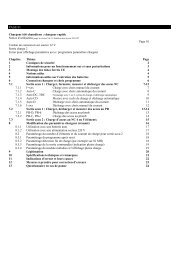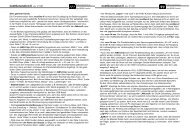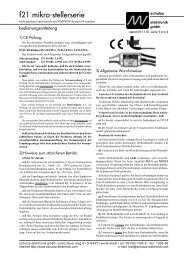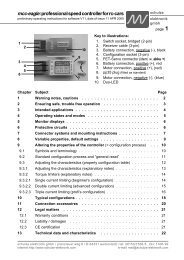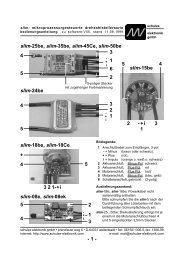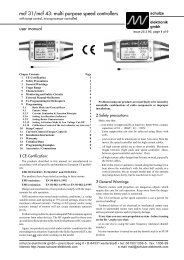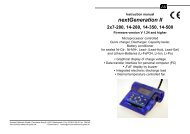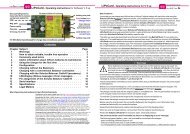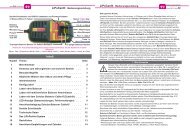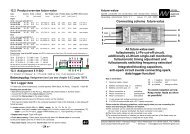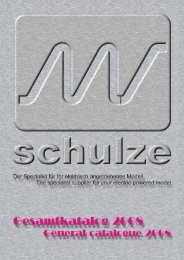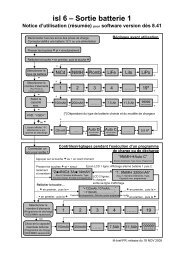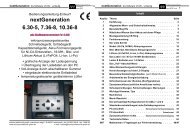nextGeneration II 2x7-280, 14-280, 14-350 - Schulze Elektronik GmbH
nextGeneration II 2x7-280, 14-280, 14-350 - Schulze Elektronik GmbH
nextGeneration II 2x7-280, 14-280, 14-350 - Schulze Elektronik GmbH
You also want an ePaper? Increase the reach of your titles
YUMPU automatically turns print PDFs into web optimized ePapers that Google loves.
34<br />
Page Issue 03.10<br />
Operating<br />
instructions<br />
Issue 03.10, page<br />
<strong>nextGeneration</strong> <strong>II</strong> Firmware version V 1.00 and higher<br />
<strong>nextGeneration</strong> <strong>II</strong> Firmware V 1.00 and higher 15<br />
20 Protection circuits, error-messages and warnings<br />
The <strong>nextGeneration</strong><strong>II</strong> is equipped with various protection and control circuits to monitor<br />
car battery voltage, charger temperature, maximum power etc.<br />
Exceeding the limits it will interrupt the charge in some cases (e.g. car battery overvoltage).<br />
The cause will be displayed and the buzzer will be activated for a short time.<br />
The symbols < and > may be displayed. ‘>’ means bigger, ‘= 100 exists then the charger must be disconnected<br />
from the car battery/power supply.<br />
Hint: All error- or warning-codes which begins (first digit) with "1" indicates that an error at<br />
the output number 1 was detected e.t.c. All messages with a leading "9" indicates an<br />
overload of the <strong>nextGeneration</strong><strong>II</strong> itself.<br />
Error text with code numbers for pack 1, pack 2<br />
Battery voltage below min. 11, 21<br />
Max. Battery voltage exceeded 13, 23<br />
Wrong cell count of Lead- or Lithium battery 17/117, 27/227<br />
Max. Charge current exceeded 161, 261<br />
Max. Discharge current exceeded 162, 262<br />
Max. Charge power of converter exceeded 177, 277<br />
Max. Discharge power of converter exceeded 178, 278<br />
Coupling of battery 1 to battery 2 charge circuit defective (next-<strong>14</strong> only) 199<br />
Max. Device input current (primary current) exceeded 961<br />
Max. Device temperature exceeded 981<br />
Car battery voltage exceeded 906<br />
Car battery voltage at minimum 5<br />
Car battery voltage below minimum 904<br />
Charge -time /-quantity /-temperature /-voltage exceeded TIME / QUAN / TEMP / Umax<br />
Temperature sensor activated, but disconnected or broken lead Toff<br />
Some typical user errors will be listed in more detail, which we strongly recommend you to<br />
read before sending the <strong>nextGeneration</strong><strong>II</strong> for a repair as you may simply avoid them:<br />
„BalCabXX is wrong“ (Warning 16, Error 116)<br />
When the <strong>Schulze</strong> BalCab connector of a Li-Po or Li-Io battery is configured incomplete (current/<br />
capacity resistor is missing) and is connected to one of the BalCab-connectors then the charger<br />
uses the manually configured charge/discharge current for max. 30 seconds - except when the error<br />
warning is consciously ignored(!) and confirmed by pressing the button.<br />
WARNING: When the BalCab is configured to Li-Fe the charger is unable to detect that<br />
the resistor is missing. The <strong>nextGeneration</strong><strong>II</strong> is charging/discharging with the manually<br />
configured battery type(!) and current(!).<br />
7.7.2 left - Battery type: e. g.: „bType : NiMH“<br />
7.7.3 le - Program selection: suggested setting for<br />
Ni-Cd and NiMH batteries: „prog. : autoC“<br />
7.7.4 le - Charge current: „cCurr: x.xx A“. If an automatic<br />
program is used (see 7.7.3 left), this parameter should<br />
generally be set to the maximum possible charge<br />
current, since the automatic circuit continuously varies<br />
the current during the charge process.<br />
Special hint: Placing a “lid” on the current - especially<br />
if it is below 1C for Ni-MH batteries or below 2C for Ni-<br />
Cd batteries - may cause the automatic cut-off circuit to fail.<br />
7.7.5 le - Discharge current: We recommend „dCurr: = max. device current" for the autoD selection.<br />
7.7.6 le - Automatic cut-off: Method of working of the automatic cut-off circuit. The setting which works<br />
with most batteries is: “cutOf:norm.” for Ni-Cd batteries or “cutOf:sens.” (sensitive) for Ni-MH batteries.<br />
7.7.7 le - Delayed response of the cut-off circuit: Deep-discharged batteries tend to cause a premature<br />
cut-off in the first few minutes of a charge process. This menu point prevents the charger checking for<br />
“battery full” for several minutes, but please note that it can lead to overheating if a fully charged battery<br />
is connected. „delay : 7min“ is fixed at Ni-MH batteries and "autoC".<br />
7.7.2 right - Cell count: Using a Nickel battery the cell count remains at zero, as no battery is connected<br />
to the charger. The charger automatically corrects the cell count during the charge or discharge process<br />
- repeatedly if necessary. Note: It is certainly possible to correct the cell count manually while a charge<br />
or discharge program is in progress, but the cell counts calculated by the unit are generally accurate<br />
enough, and are not used when charging Nickel cells in any case.<br />
7.7.3 ri - Setting the C-Rate: By the definition of the <strong>Schulze</strong>-balancing cables for Lithium batteries the<br />
charge current depends on the current resistor soldered in. If you wish to use a higher (or lower) charge<br />
current than defined by the configuration of the lead, you can “turn this parameter up or down”. Normally<br />
the current multiplication factor is set to 1.0: „cRate: 1.0“.<br />
7.7.4 ri - Charge quantity limitation: An important factor in terms of safety is the maximum charge<br />
quantity (battery capacity). You need to estimate how much energy can be charged into your battery.<br />
A normal, completely discharged Ni-Cd 2400 mAh cell can generally accept 2400 - 2600 mAh.<br />
This means: The maximum charge quantity for flat 2400 cells "quan> 2700" mAh.<br />
For Ni-MH cells the basic rule is to set the battery capacity in mAh, plus an addition of about 30%,<br />
since the charge quantity limit has a dual function (see Chapter xx).<br />
7.7.5 ri - Charge time limitation: The next safety function is to enter the maximum charge time. The<br />
charge time for a fully automatic charge program can only be estimated, as the actual period varies<br />
according to the specific cell type. If you do not already know this figure from personal experience, we<br />
suggest that you enter a figure at the higher end of the range: Time> 30…45min (for Ni-Cd cells).<br />
Please note: If the charge time exceeds three hours, something is fundamentally wrong: either the<br />
battery is defective or of high internal resistance (e.g. many AA and AAA cells), the charge leads are<br />
too thin, or the connectors are not up to the job.<br />
7.7.6 ri - Over temperature cut-off: The temperature cut-off should be left at OFF: “temp>: OFF” (in<br />
particular if the nextConn circuit board is not installed. See Chapter <strong>14</strong> for more details).<br />
7.7.7 ri - Discharge protection diode: This is only required for transmitters fitted with an integral<br />
protective discharge diode; the ideal choice is therefore normally: “diode: OFF”.<br />
If lithium- or lead-batteries with buildt-in diode are charged, then the batteries are not full despite the<br />
„full“ display. The reason is that the <strong>nextGeneration</strong><strong>II</strong> is not able to detect the diode.<br />
7.7.8 ri - Refresh charge: Refresh charge: this should be switched on if you wish to subject your battery<br />
to brief discharge pulses during the charging process. It is claimed that tired batteries can be revived<br />
more quickly using this method, and it is likely that the principle could be relatively successful with<br />
transmitter and receiver batteries, which are almost never discharged completely. However, since the<br />
process does not compensate for differences in self-discharge rates between the individual cells of the<br />
pack, and since it does not increase the capacity of the cells, this function is purely a matter of taste …<br />
refresh charging is switched off in any case when charging Lithium batteries with the Balancer active,<br />
as it could have adverse effects.<br />
1 le<br />
2 le<br />
3 le<br />
4 le<br />
5 le<br />
6 le<br />
7 le<br />
8 le<br />
Parameter screen battery 1 Fig. 7.7.x<br />
Parameter Parameter Set Set battery battery 1<br />
1 1 ri<br />
bType bType® bType NiMH NiMH cells cells® cells 0<br />
0 2 ri<br />
prog. prog. prog.®autoC prog. autoC cRate cRate® cRate -<br />
- 3 ri<br />
cCurr cCurr cCurr®3.50A cCurr 3.50A quan> quan>® quan> 500 500<br />
500 4 ri<br />
dCurr dCurr dCurr®5.00A dCurr 5.00A time> time>® time> 2h30<br />
2h30 5 ri<br />
cutOf cutOf cutOf®sens. cutOf sens. temp> temp>® temp> OFF<br />
OFF 6 ri<br />
delay delay delay® delay 7min 7min diode diode® diode NO<br />
NO 7 ri<br />
stora stora stora® stora NO NO refr. refr.® refr. OFF<br />
OFF 8 ri



